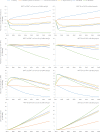Changing HIV treatment eligibility under health system constraints in sub-Saharan Africa: investment needs, population health gains, and cost-effectiveness
- PMID: 27367487
- PMCID: PMC5017264
- DOI: 10.1097/QAD.0000000000001190
Changing HIV treatment eligibility under health system constraints in sub-Saharan Africa: investment needs, population health gains, and cost-effectiveness
Abstract
Objective: We estimated the investment needs, population health gains, and cost-effectiveness of different policy options for scaling-up prevention and treatment of HIV in the 10 countries that currently comprise 80% of all people living with HIV in sub-Saharan Africa (Ethiopia, Kenya, Malawi, Mozambique, Nigeria, South Africa, Tanzania, Uganda, Zambia, and Zimbabwe).
Design: We adapted the established STDSIM model to capture the health system dynamics: demand-side and supply-side constraints in the delivery of antiretroviral treatment (ART).
Methods: We compared different scenarios of supply-side (i.e. health system capacity) and demand-side (i.e. health seeking behavior) constraints, and determined the impact of changing guidelines to ART eligibility at any CD4 cell count within these constraints.
Results: Continuing current scale-up would require US$178 billion by 2050. Changing guidelines to ART at any CD4 cell count is cost-effective under all constraints tested in the model, especially in demand-side constrained health systems because earlier initiation prevents loss-to-follow-up of patients not yet eligible. Changing guidelines under current demand-side constraints would avert 1.8 million infections at US$208 per life-year saved.
Conclusion: Treatment eligibility at any CD4 cell count would be cost-effective, even under health system constraints. Excessive loss-to-follow-up and mortality in patients not eligible for treatment can be avoided by changing guidelines in demand-side constrained systems. The financial obligation for sustaining the AIDS response in sub-Saharan Africa over the next 35 years is substantial and requires strong, long-term commitment of policy-makers and donors to continue to allocate substantial parts of their budgets.
Figures



Similar articles
-
The HIV Treatment Gap: Estimates of the Financial Resources Needed versus Available for Scale-Up of Antiretroviral Therapy in 97 Countries from 2015 to 2020.PLoS Med. 2015 Nov 24;12(11):e1001907; discussion e1001907. doi: 10.1371/journal.pmed.1001907. eCollection 2015 Nov. PLoS Med. 2015. PMID: 26599990 Free PMC article.
-
Multi-country analysis of treatment costs for HIV/AIDS (MATCH): facility-level ART unit cost analysis in Ethiopia, Malawi, Rwanda, South Africa and Zambia.PLoS One. 2014 Nov 12;9(11):e108304. doi: 10.1371/journal.pone.0108304. eCollection 2014. PLoS One. 2014. PMID: 25389777 Free PMC article.
-
Impact of "test and treat" recommendations on eligibility for antiretroviral treatment: Cross sectional population survey data from three high HIV prevalence countries.PLoS One. 2018 Nov 26;13(11):e0207656. doi: 10.1371/journal.pone.0207656. eCollection 2018. PLoS One. 2018. PMID: 30475865 Free PMC article.
-
Modeling the implementation of universal coverage for HIV treatment as prevention and its impact on the HIV epidemic.Curr HIV/AIDS Rep. 2014 Dec;11(4):459-67. doi: 10.1007/s11904-014-0232-x. Curr HIV/AIDS Rep. 2014. PMID: 25249293 Free PMC article. Review.
-
Review of antiretroviral therapy coverage in 10 highest burden HIV countries in Africa: 2015-2020.J Med Virol. 2023 Jan;95(1):e28320. doi: 10.1002/jmv.28320. J Med Virol. 2023. PMID: 36397202 Review.
Cited by
-
Assessing frontline HIV service provider efficiency using data envelopment analysis: a case study of Philippine social hygiene clinics (SHCs).BMC Health Serv Res. 2019 Jun 24;19(1):415. doi: 10.1186/s12913-019-4163-5. BMC Health Serv Res. 2019. PMID: 31234853 Free PMC article.
-
Matching Microsimulation Risk Factor Correlations to Cross-sectional Data: The Shortest Distance Method.Med Decis Making. 2018 May;38(4):452-464. doi: 10.1177/0272989X17741635. Epub 2017 Nov 29. Med Decis Making. 2018. PMID: 29185378 Free PMC article.
-
Empirical estimation of resource constraints for use in model-based economic evaluation: an example of TB services in South Africa.Cost Eff Resour Alloc. 2018 Jul 30;16:27. doi: 10.1186/s12962-018-0113-z. eCollection 2018. Cost Eff Resour Alloc. 2018. PMID: 30069166 Free PMC article.
-
The impact of the PEPFAR funding freeze on HIV deaths and infections: a mathematical modelling study of seven countries in sub-Saharan Africa.EClinicalMedicine. 2025 Apr 25;83:103233. doi: 10.1016/j.eclinm.2025.103233. eCollection 2025 May. EClinicalMedicine. 2025. PMID: 40626258 Free PMC article.
-
Costs and Cost-Effectiveness of Biomedical, Non-Surgical HIV Prevention Interventions: A Systematic Literature Review.Pharmacoeconomics. 2023 May;41(5):467-480. doi: 10.1007/s40273-022-01223-w. Epub 2022 Dec 19. Pharmacoeconomics. 2023. PMID: 36529838 Free PMC article.
References
-
- UNAIDS. Report on the global AIDS epidemic 2015. Geneva: UNAIDS; 2015.
-
- Govindasamy D, Ford N, Kranzer K. Risk factors, barriers and facilitators for linkage to antiretroviral therapy care: a systematic review. AIDS 2012; 26:2059–2067. - PubMed
-
- UNAIDS. AIDSinfo Online Database. http://aidsinfoonline.org/devinfo/libraries/aspx/Home.aspx [Accessed 1 August 2015].
Publication types
MeSH terms
Substances
LinkOut - more resources
Full Text Sources
Other Literature Sources
Medical
Research Materials

